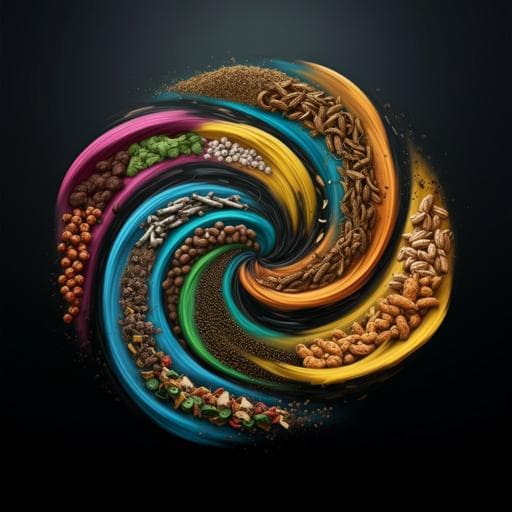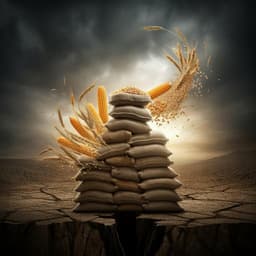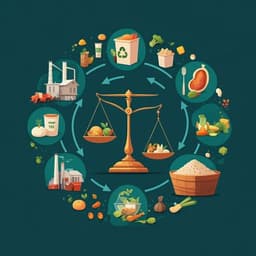
Food Science and Technology
Food system by-products upcycled in livestock and aquaculture feeds can increase global food supply
V. Sandström, A. Chrysafi, et al.
This groundbreaking study reveals how leveraging food system by-products and residues for animal feeds could potentially enhance global food supply by up to 13% (kcal) and 15% (protein). Conducted by a team of experts including Vilma Sandström and Anna Chrysafi from Aalto University, the research highlights a promising pathway towards circular food systems.
~3 min • Beginner • English
Introduction
A substantial share of global crops and wild fish is diverted to animal feeds, creating competition between feed and food. Up to 40% of arable land and over 30% of cereal production serve animal feeds, and about 23% of captured fish go to non-food uses, largely feed. This lowers overall food system efficiency because producing feed on arable land carries higher environmental and resource costs compared to direct human food production. Using food system by-products—secondary products generated alongside human-edible commodities—as animal feed has been suggested to improve resource efficiency, reduce food-feed competition, enhance circularity, and ease environmental pressures. However, not all by-products are nutritionally suitable without processing (e.g., crop residues are fibrous and low in digestibility; some processing by-products are protein-dense but energy-poor). Despite these challenges, part of the current food-competing feed use could be replaced without harming productivity. This study asks: to what extent can food-competing feedstuffs in global livestock and aquaculture be replaced by food system by-products and residues, considering regional availability and nutritional constraints, and what is the potential increase in human food supply as a result?
Literature Review
Prior work highlights large resource flows into feed and associated inefficiencies. Studies have advocated feeding only non-food-competing biomass to livestock, sometimes with accompanying changes in livestock output and diets, to sustain global food supply. Global datasets that comprehensively harmonize feed material flows alongside by-product and residue availability across both livestock and aquaculture had been lacking. Existing models often focus on either livestock or aquaculture, omit country-level differences, or restrict analyses to regional scopes. Estimates of by-product flows have been sporadic, and feed-use potentials have mostly been assessed for individual by-products within specific systems. Previous scenario assessments showed the feasibility of livestock systems based on non-food-competing feedstuffs, but without a harmonized global accounting of by-product availability and nutritional constraints across sectors. This study advances the literature by: (1) compiling and harmonizing global material flows for crops, livestock, aquaculture and wild fisheries; (2) quantifying the availability of key by-products and residues and their current versus potential feed use; and (3) assessing replacement potential of food-grade feedstuffs with by-products across regions and species while incorporating nutritional and regulatory constraints from extensive feed experiment literature.
Methodology
The analysis covered a three-year average (2016–2018) and proceeded in four steps: (1) Quantify global food system flows, including nation-level feed use in livestock and aquaculture and potential by-product production. (2) Estimate regional availability of by-products and residues by subtracting current feed use from potential production. (3) Use literature on feed experiments to derive replacement constraints for substituting food-competing feedstuffs with by-products while maintaining productivity (except where explicitly allowing productivity reductions). (4) Combine availability and constraints to compute replacement potential and then estimate the potential increase in human food supply assuming replaced feedstuffs are redirected to food. Scope and feed categories: Human-edible, food-competing feedstuffs included cereals, oilseed oils, pulses, sugar crops, and whole fish used for fishmeal and fish oil. Roughages, crop residues, and crop processing co-products (e.g., oilseed meals, cereal bran) were treated as non-food-competing. Feed use estimation: For livestock, national outputs (cattle meat and dairy, poultry meat and eggs, pork) from FAO were multiplied by production system shares (FAO GLEAM) and regional FCRs derived from Mekonnen & Hoekstra, Mottet et al., and Herrero et al., harmonized to dry matter per product using protein contents. Species- and system-specific diets were assigned using ref. datasets, adjusting an aggregated grains category for ruminants to maize, wheat, and barley. Fishmeal inclusion in pig and poultry diets was corrected using species-specific inclusion rates. For aquaculture, fed groups (e.g., carps, tilapias, catfish, salmonids, marine fishes, shrimps) were multiplied by FCRs (commercial feeds from literature; farm-made feeds assumed 50% higher FCR). Diet compositions came from country surveys and were scaled to 100% inclusion by average shares. Fishmeal and fish oil from processing by-products were assumed to supply 25–35% of total quantities. Totals were validated against FAO Supply and Utilization Accounts for cereals, pulses, vegetable oils, and molasses. By-product and residue availability: Four categories were quantified—(1) crop residues (cereals, rice, sugar cane, pulses) via residue-to-production ratios and maximum sustainable harvest rates (0–50%) to maintain soil quality; (2) crop processing by-products: cereal bran (FAO), distiller’s grains (corn ethanol and brewing), sugar beet pulp and molasses (conversion factors and processing loss adjustments), citrus pulp (processing conversion minus losses), and oilseed meals (converted from processed oilseeds); (3) livestock by-products (non-ruminant origin): poultry by-product meal, poultry oil, blood meal, hydrolysed feather meal, meat meal, estimated from live weight (via dressing percentages) and by-product ratios; (4) fish by-products for fishmeal and fish oil: aquaculture and capture fisheries volumes partitioned to human consumption vs non-food, correcting species with higher non-food shares; by-product quantities from processed fish for human consumption assumed at 41.5% trimmings minus 2% blood and 2% primary processing losses, with conversion ratios 0.2 (fishmeal) and 0.04 (fish oil). All quantities were converted to dry matter. Replacement constraints: Derived from feed experiment literature assuming no productivity loss, except for cereal replacement with crop residues in cattle, which implies 40–80% productivity reduction; this reduction was accounted for in the food-supply calculation. Assumptions included: 75–100% replacement of fishmeal in pig and poultry by oilseed meals, fishmeal from fish by-products, or non-ruminant livestock by-products; in aquaculture, 27–79% of fishmeal and 51–79% of fish oil can be replaced by livestock by-products, and 75–100% of fishmeal/oil from whole fish can be replaced by those made from fish by-products. Distiller’s grains were excluded as fishmeal replacements in aquafeeds without further processing. Cereal substitutes considered included cereal brans, distiller’s grains, sugar beet pulp, molasses, and citrus pulp; for ruminants, crop residues can replace part of cereals with reduced productivity. Pulses in livestock feeds were assumed replaceable by oilseed meals and non-ruminant livestock by-products (75–100% substitution; rapeseed/soy meals 100% in literature). Regulatory constraints: EU-style restrictions were applied globally as a precaution—no intra-species recycling; ruminant-origin processed by-products excluded from livestock/aquaculture feeds; only non-ruminant animal by-products allowed where consistent with bans. Replacement potential calculation: For each food-competing feedstuff and animal group, maximum/minimum replacement was computed from constraints, capped by regional availability of replacement materials. Potentials across replacement materials were summed within animal groups and normalized not to exceed total feed use, then aggregated across groups and regions. Two cereal scenarios were analysed: (1) replacement without crop residues (no productivity impact), and (2) adding crop residues with proportional 40–80% productivity reduction in cattle meat and dairy. Trade and allocation: Inter-regional trade of by-products/residues was excluded (intra-regional trade allowed). Oilseed meals and fishmeal are highly traded, so in regions with negative availability the replacement potential for those items was set to zero. Increased food supply was computed by multiplying replaced feed amounts by energy, protein, and fat contents, avoiding double counting for fishmeal and fish oil by considering only the higher replacement (fishmeal). Uncertainty analysis: Monte Carlo simulations (n=500) combined uncertainties in livestock/aquaculture FCRs (truncated normal using reported ranges), conversion factors for by-products and residues (uniform distributions with CV=0.1), and replacement constraint ranges (uniform).
Key Findings
• Food-competing feed use: About 15% of total feedstuffs (940 million tons dry matter out of 6,100 million tons) used in livestock and aquaculture are human-edible (cereals, pulses, vegetable oils, whole fish). Shares by sector: aquaculture 49% of its feed use (67 Mt total feed), poultry 68% (421 Mt), pork 38% (1,200 Mt), cattle meat and dairy 3–4% (5,200 Mt and 1,920 Mt total feed, respectively). Regional food-competing feed shares range from <4% (Africa) to ~20% (North America). Cereals dominate food-competing feedstuffs, with maize the largest. • By-product availability: Crop residues and livestock by-products have low current feed use relative to potential; nearly all oilseed meals are already used for feed; more than half of cereal and sugar processing by-products are already used. Despite competing uses, crop residues present the highest theoretical availability. • Replacement potential without productivity loss: 11–12% of food-competing feedstuffs could be replaced globally by selected by-products given constraints and availability. With crop residues included (and reduced cattle productivity accounted for), potential rises to 25–29%. Fishmeal and fish oil from whole fish show the highest relative replacement potential (≈91–100%). • Freed food supply: Maximum replacement could free 430–650 × 10^12 kcal (about 5–7% of current global food energy supply) and 17–26 million tons of protein (about 7–11% of current supply). Including crop residues increases this to about 12.9% of calories and 15.0% of protein. • Specific commodities freed for human use: 72–103 million tons of cereals (~10% of feed cereal use); 3.8–6.0 million tons of vegetable oils (~31–42% of feed oil use); 8–19 million tons of pulses (~50–88% of feed pulse use); 2.9–3.9 million tons of fishmeal from whole fish (equivalent to >17 million tons of whole fish, ~11% of current seafood supply). • Land implications: Replacing feed use with by-products could free 31–54 million hectares of cropland; including crop residues could free >100 million hectares (~7% of global arable land in 2018). • Utilization balance: Under maximum replacement, most cereal and sugar processing by-products would be utilized; large shares of fishmeal from fish by-products, livestock by-products, and crop residues would remain available for other uses.
Discussion
The study shows that redirecting food-competing feedstuffs to humans by replacing them in animal diets with by-products and residues can substantially increase global food availability without expanding natural resource use. The largest gains come from reducing cereal use in feed, though replacing whole-fish-based fishmeal/oil and pulses in feeds also yields notable protein and fat for human diets. Regional variation in by-product availability and current feed practices implies that potentials are unevenly distributed; intra-regional trade was allowed, but broader trade could further enhance replacement potential in some regions. Additional sources, such as pre-consumer food waste and former foods, could increase potentials beyond those reported. Practical constraints include regulations on animal by-product use (e.g., intra-species bans, ruminant-origin restrictions), nutritional limitations (fibre, antinutritional factors, essential fatty acids), potential productivity impacts (notably with crop residues), perishability and seasonality of by-products, and infrastructural needs for stabilization, collection, transport, storage, and processing. Competing uses of by-products (bioenergy, fertilizer, pharmaceuticals) must be considered, although even under maximum replacement many residues and animal by-products remain for other uses. Increasing human consumption of freed feed-grade products also poses challenges (quality standards, need for processing, cultural preferences), especially for small pelagic fish traditionally used for reduction. Overall, the results provide a biophysical upper bound on how circular feed strategies can alleviate food-feed competition; realizing this potential will require coordinated policy, market incentives, technology to upgrade by-products, and tailored strategies across regions and supply chains.
Conclusion
By harmonizing global feed material flows with quantified availability of by-products and applying species- and region-specific nutritional and regulatory constraints, the study demonstrates that substituting food-competing feedstuffs with food system by-products and residues could increase global food energy by up to ~13% and protein by ~15% (including crop residues with managed productivity impacts). This supports the transition to more circular, resource-efficient food systems. Key contributions include a comprehensive global accounting of feed flows, by-product availability, and realistic replacement potentials across livestock and aquaculture. Future research should: (1) expand the portfolio of by-products (e.g., dairy and bakery by-products) and include food waste streams; (2) integrate inter-regional trade and economic factors; (3) evaluate environmental performance and health/nutritional outcomes of replacement strategies; (4) refine species- and life-stage-specific nutritional constraints and combined inclusion effects; and (5) conduct local and sectoral case studies to assess feasibility, costs, and policy mechanisms. Policy interventions are needed to incentivize utilization of underused by-products, enable safe use of animal by-products where appropriate, and support infrastructure for collection and processing.
Limitations
• Data and parameter uncertainties: FCRs sourced from studies circa 2000–2010; improvements since then may alter feed use estimates. Species-, system-, and region-specific data gaps remain, especially in low-income countries. • Scope constraints: Inter-regional trade of by-products was excluded; only intra-regional trading allowed, which may understate replacement in trade-dependent areas. Environmental performance was not assessed. • Regulatory assumptions: Applied EU-like restrictions globally; actual regulations vary and could either constrain or enable greater replacement. • Nutritional constraints: Replacement rates derive from studies of individual by-products; combined inclusion effects in practical rations may differ and affect palatability, health, and productivity. • Exclusions: Some food-competing categories (e.g., roots and tubers) and by-product streams (e.g., dairy/bakery) and post-consumer food waste were not included; potentials may therefore be conservative or require further qualification. • Quality and acceptance: Not all feed cereals meet food-grade standards; shifting to food-grade production may require additional inputs and may face consumer preference barriers (e.g., small pelagic fish for direct consumption). • Productivity impacts: Inclusion of crop residues entails 40–80% productivity reductions in cattle; broader system-level implications (economic, welfare) were not modeled.
Related Publications
Explore these studies to deepen your understanding of the subject.







